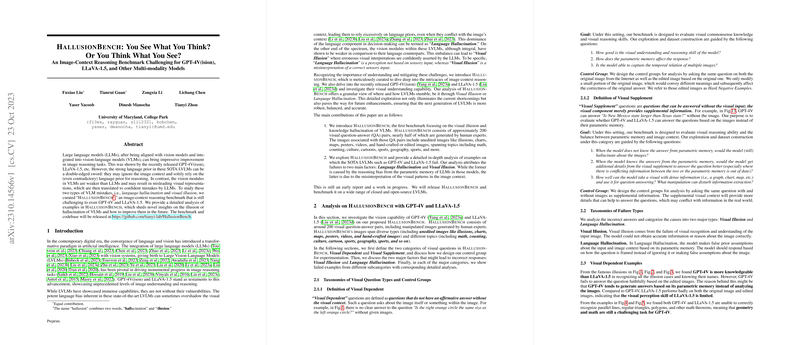An Evaluation of HallusionBench: Diagnosing Hallucination and Illusion in Vision-LLMs
The paper presents "HallusionBench," a diagnostic benchmark suite developed to evaluate advanced visual-LLMs (LVLMs) on their abilities to process and synthesize image-context reasoning. This benchmark was developed with the express aim of quantifying the hallucination and illusion capabilities intrinsic to LVLMs, especially for models integrated with high-caliber LLMs. The benchmark is thoroughly challenging for state-of-the-art visual models such as GPT-4V, Claude 3, and others by pushing these systems beyond typical performance metrics into nuanced territories of logic, reasoning, and contextual comprehension.
Structure and Content of HallusionBench
At its core, HallusionBench consists of 346 images coupled with 1129 expertly crafted questions. These questions are structured into visual question (VQ) pairs that provide a controlled experimental environment to analyze both the overt capabilities and the limitations of various models. This structure permits a granular investigation into specific failure modes and response tendencies, presenting invaluable insights into logical consistency and model robustness.
The paper emphasizes the distinct evaluation of visual dependent questions, which require visual context to provide a logical response, and visual supplement questions, which rely on visual data as supplementary information to otherwise abstract queries. This dual-structure enables a multi-faceted analysis of how deep learning models in the LVLM category process visual data, especially when there is an inherent language bias that could overshadow visual inputs.
Major Findings and Model Performance
The empirical evaluation highlights key findings about the performance of current state-of-the-art models. Notably, GPT-4V achieved a question-pair accuracy of 31.42%, underscoring both its current capability and limitation when dealing with complex reasoning tasks. In comparison, other advanced LVLMs showcased a performance below 16%, suggesting significant room for improvement in hallucinatory error mitigation.
Diving deeper, the paper elucidates that LVLMs, while proficient in some aspects of visual understanding, are pronouncedly prone to two main issues: the illusion of recognition and hallucinatory responses when the models' language biases conflict with visual inputs. This is especially prevalent in controlled settings included in HallusionBench, demonstrating how these biases manifest when evaluating models on accuracy, logical consistency, and robustness across diverse visual modalities.
Implications and Future Directions
A significant implication stemming from this research is the necessity for enhanced training datasets and methodologies that prioritize the balance between language and visual understanding. Developing models with robust visual validation techniques to counteract hallucinatory tendencies could mitigate these issues. By examining identified failure modes, we can formulate strategies for targeted improvements in model architectures to optimize the handling of nuanced contexts.
HallusionBench sets a new benchmark standard for evaluating LVLMs, pushing future research to explore improved approaches that account for the intricacies highlighted by this paper. Potential development might focus on refining models to adeptly balance parametric memory with real-time visual inputs, honing the capacity for temporal reasoning and context-sensitive understanding. The work encourages the continued evolution of benchmark suites that can adapt and challenge models in increasingly complex scenarios, ultimately improving the next generation of LVLMs.
In summary, HallusionBench stands as a pivotal tool for diagnosing and understanding limitations in current visual-LLMs, paving the way for innovative strategies in model training and architecture refinement. By providing a detailed expanse of case studies and metric analyses, the paper offers insightful perspectives into the ongoing challenges and demands in the field of vision-language integration.
